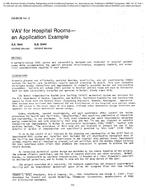Click here to purchase
High-efficiency natural gas-fired space and water heating systems are an integral part of Low Energy Design, offering equipment installation flexibility at minimum operating cost. These systems are largely installed with sidewall vents in new and retrofit single family and multifamily buildings when venting through the roof is not practical, is prohibited by local code, or is beyond the maximum length of the vent system permitted by the manufacturers’ installation instructions.
The industry continues to investigate sidewall venting systems design and installation practices to improve building design flexibility, improve vent performance under extreme conditions, avoid nuisance outages, and avoid other occurrences such as ice formation on nearby structures. This paper investigates sidewall vent plume formation and the potential for ice formation on nearby structures in very cold climates. A review of the literature on turbulent buoyant round jet formation and transition from momentum-driven to buoyancy-driven flow is discussed as well as results of computational fluid dynamics (CFD) modeling of several geometries. CFD is a finite difference model that calculates the fluid parameters based on the physics of the fluid flow and surrounding conditions. Recommendations are made for improving sidewall vent performance and supporting flexible Low Energy Design practices.
Citation: ASHRAE Conference Papers, Las Vegas, NV
Product Details
- Published:
- 2011
- Number of Pages:
- 8
- File Size:
- 1 file , 2 MB
- Product Code(s):
- D-LV-11-C063


